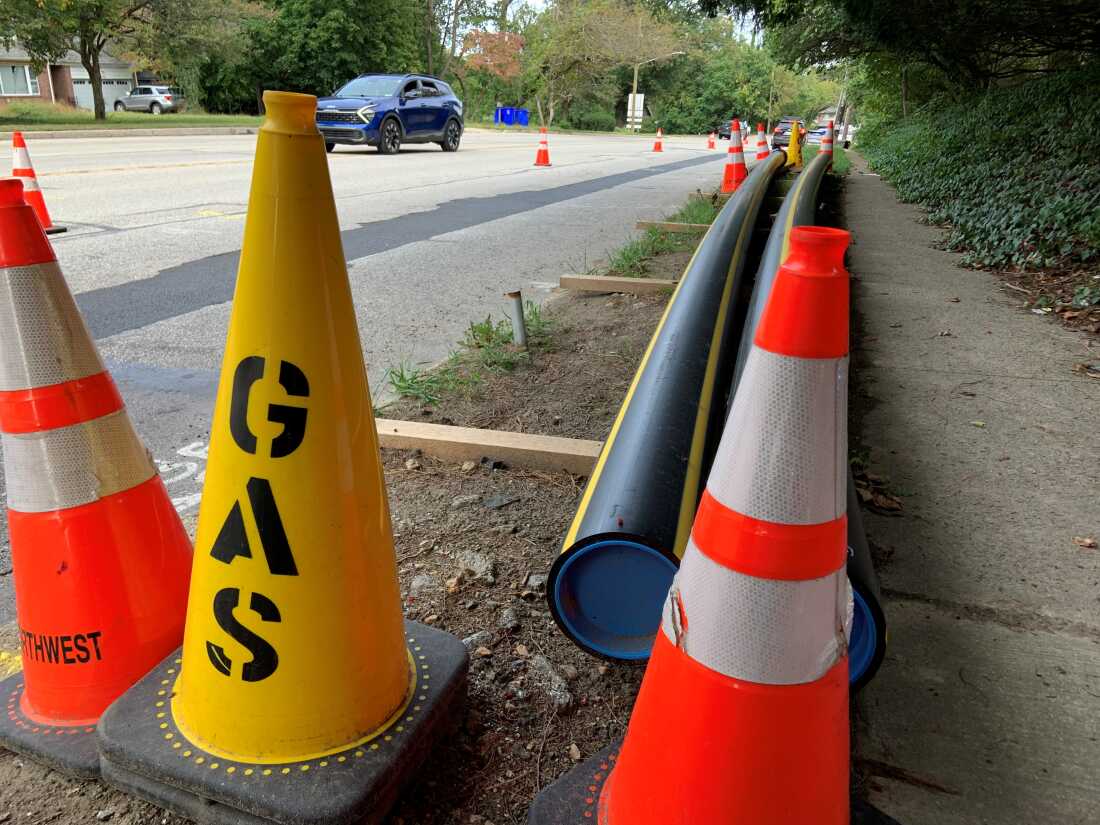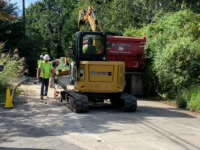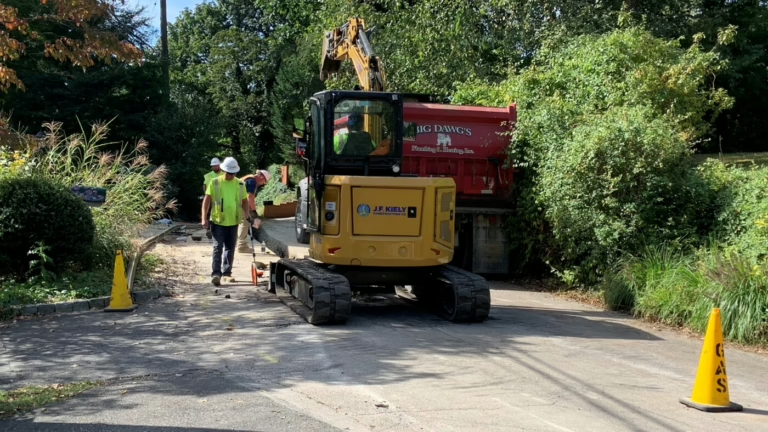In Wyncote, Pennsylvania, a crew replaces aging gas pipelines that leak methane, a potent greenhouse gas. These infrastructure projects are contributing to rising gas bills, despite wholesale gas prices remaining relatively low.
Jeff Brady/NPR
hide caption
toggle caption
Jeff Brady/NPR
Michelle Lordi, a resident of Wyncote, a suburb near Philadelphia, has recently observed a noticeable increase in her gas utility bills.
“This past winter, our bills reached into the thousands,” Lordi shared outside her home, where crews were busy replacing outdated gas lines. Although her bill covers both gas and electricity, the bulk of the charges during the cold months come from gas usage.
She now suspects a direct link between the construction activity in her neighborhood and the surge in her gas expenses. “It seems like they’re dismantling every piece of infrastructure around here,” she remarked. “That kind of work must be costly, especially with so many workers involved.”
PECO, the local utility company formerly known as the Philadelphia Electric Company, has announced plans to invest approximately $1.8 billion over five years to modernize its gas pipelines and related infrastructure. As a regulated monopoly, these expenses are passed on to consumers through their utility bills.
This scenario in Wyncote reflects a broader national pattern. Across the United States, even though wholesale natural gas prices remain relatively affordable, residential gas rates are climbing toward historic highs. The primary drivers of these increases are infrastructure upgrades, construction costs, operational expenses, and taxes, rather than the cost of the gas itself.
The extensive pipeline replacement efforts stem from safety concerns following a fatal gas pipeline explosion in 2010. While these upgrades aim to enhance safety and reliability, they coincide with growing scientific consensus that society must reduce reliance on fossil fuels, including natural gas. This has sparked debate among environmental advocates about the wisdom of investing heavily in infrastructure that may become obsolete within a few decades.
In response, some states have begun directing utilities to explore more cost-effective safety measures, such as decommissioning certain pipeline segments instead of replacing them outright.
Surge in Infrastructure Investment
Spending on gas infrastructure has surged dramatically, with a 50% increase from 2022 to 2023, reaching $49.1 billion, according to the American Gas Association (AGA), the leading trade organization for gas utilities.
This wave of investment was spurred by federal initiatives following the 2010 San Bruno, California pipeline disaster, which resulted in eight fatalities and widespread property damage. The explosion was traced to a defective weld in a pipeline installed decades earlier.
Federal regulations encouraged utilities to repair, rehabilitate, or replace aging iron and steel pipelines to prevent similar tragedies. However, utilities, with regulatory approval, have predominantly chosen the most expensive option: full pipeline replacement. This preference is influenced by the financial model under which utilities operate.
Gas companies typically do not profit from the gas commodity itself; instead, they recover costs and earn returns through investments in infrastructure such as pipelines. Regulators allow these costs, plus a profit margin, to be included in customer bills.
“This approach has significantly driven up rates,” explains Abe Scarr, director of the energy and utilities program at the consumer advocacy group Public Interest Research Group (PIRG). “For example, delivery rates have doubled in Chicago and tripled in Baltimore Gas and Electric’s service area in Maryland.”
Scarr led efforts to challenge Peoples Gas’ pipeline replacement program in Chicago, which was criticized for exceeding budgets and conflicting with Illinois’ climate objectives. After studies projected that gas bills could double over 15 years, regulators scaled back the program, directing the utility to prioritize replacing only the most vulnerable pipelines.
Over the past four decades, the composition of gas utility bills has shifted dramatically. In 1984, about two-thirds of a typical bill covered the cost of gas itself, with the remainder allocated to infrastructure, operations, and taxes. By 2024, this ratio has reversed, with less than one-third of bills reflecting gas costs and the majority covering other expenses.
Potential Impact of Gas Exports on Prices
Utilities often highlight that natural gas remains one of the most economical options for heating homes during winter, according to the Energy Information Administration. PECO notes that its gas rates have stayed below inflation since 2011, attributing the smaller share of gas costs in bills to the relative affordability of the fuel, even as construction expenses have risen.
“Inflation affects material and labor costs, which contribute to higher infrastructure expenses,” says Richard Meyer, AGA’s vice president of energy markets and standards.
In a statement, the AGA emphasized that when adjusted for inflation, current utility bills are near historic lows. Advances in appliance efficiency and lower wholesale gas prices have helped mitigate the impact of rising infrastructure costs.
“Our industry has invested heavily in upgrading the natural gas system to improve safety and reduce emissions without causing significant cost fluctuations for consumers,” said Karen Harbert, AGA’s president and CEO.
Nevertheless, critics argue that consumers are paying more to utilities while seeing less of their bill attributed to the gas itself.
“Consumers are facing higher charges without the expected savings,” Scarr notes. He also warns that federal policies promoting fossil fuel exports could tighten domestic supply and push prices even higher.

New gas pipes await installation in Wyncote, Pennsylvania, as part of PECO’s $1.8 billion, five-year infrastructure upgrade.
Jeff Brady/NPR
hide caption
toggle caption
Jeff Brady/NPR
The previous administration advocated for increased U.S. natural gas exports, which could reduce domestic availability and elevate consumer prices. However, AGA’s Meyer argues that producers will respond to higher demand by ramping up drilling and production.
“Market dynamics will adjust accordingly,” Meyer said during a recent briefing on winter heating costs. “Higher prices incentivize operators to increase output.”
Yet, expanding fossil fuel production poses significant climate risks. Scientists warn that to prevent the worst impacts of global warming, a substantial portion of fossil fuel reserves, including nearly half of natural gas, must remain unextracted.
Natural Gas and Climate Change Challenges
Natural gas primarily consists of methane, a greenhouse gas far more potent than carbon dioxide. Although utilities have made strides in reducing methane leaks, completely eliminating them remains a challenge.
A 2020 study from Princeton University evaluated the most cost-effective strategies to achieve net-zero greenhouse gas emissions by 2050, the target set by the 2015 Paris Agreement. None of the scenarios included maintaining the current structure of gas utilities.
Similar conclusions have been reached by research from the Department of Energy’s Lawrence Berkeley National Laboratory and the National Academy of Sciences, which advocate for electrifying buildings, enhancing appliance efficiency, and relying on renewable energy to cut emissions.
The gas industry is exploring alternatives such as renewable natural gas, derived from methane captured at landfills and farms, and blending hydrogen into existing pipelines. However, these initiatives have faced setbacks due to local resistance.
Regulatory Decisions Shape the Future of Gas Utilities
“We believe a gradual transition away from gas systems over the next decade is necessary,” says Scarr. “Scientific evidence supports ending the combustion of fossil fuels, including natural gas, in residential settings.”
Activists nationwide are urging state utility regulators to envision a future without traditional gas utilities, which they argue could reduce costs for consumers.
Rather than automatically replacing aging pipelines, they advocate for prioritizing less expensive options such as repairs or decommissioning sections of the network, coupled with transitioning homes to electric heating and appliances.
Massachusetts is leading this shift. This year, state regulators revamped the gas pipeline replacement program to limit expenditures on costly infrastructure that the state plans to phase out in alignment with its climate objectives.
The Massachusetts Department of Public Utilities now requires gas companies to emphasize repairs over replacements and to evaluate whether shutting down leaky pipeline segments and installing electric heat pumps in homes might be more economical.
Officials estimate that these changes could reduce the pipeline replacement surcharge on customers’ monthly bills by up to 17%.






















